Possible Benefits of Parsley in Health and Beauty
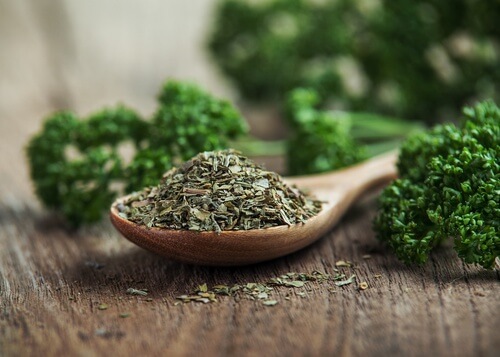

Reviewed and approved by the pedagogue in physical education and nutritionist Elisa Morales Lupayante
People oftentimes use parsley in recipes without knowing of its wonderful properties. Would you like to know how parsley can be used for health and beauty? If so, keep reading this article to discover the possible benefits of parsley and take advantage of this wonderful, aromatic plant!
Parsley is a highly recommendable plant for women. Not only may it help relieve painful menstruation symptoms, but it also may help fight menopause symptoms and reduce the risk of osteoporosis.
Discover: 5 Possible Benefits of Eating Parsley
Parsley’s characteristics
This plant belongs to the same family that celery and fennel do (which is why they have similar leaves). It has been used in cooking and also as a natural remedy for thousands of years. It’s native to the Eastern watershed in the Mediterranean and was introduced to other areas by the Greeks.
Hippocrates and Galen mention parsley in their works. The Anglo Saxons used it to treat cranial fractures caused in combat. Currently, parsley is cultivated across the entire world and is a common ingredient for adding flavor and fragrance to hundreds of dishes and beverages.
Parsley seed oil is also used in the cosmetics industry, either in soaps or creams.
Parsley contains:
- Vitamin C (1/3 c. of parsley has more vitamin C than one orange).
- Vitamin K (good for bone health and blood coagulation).
- Beta-carotenes (Antioxidants and immune-protectors).
- Calcium (1 cup of parsley has the same amount of calcium as one cup of milk).
- Potassium (500 mg of potassium per 100 grams of parsley).
- Iron (more than red meat).
- Fiber (perfect for reducing the risk of constipation and improving intestinal functions).
- Boron (may help treat menopause and reduce the risk of osteoporosis).
- Fluoride (may help strengthen bones).
- Chlorophyll (which is what gives parsley its green color, and it has antiseptic and cleansing properties).
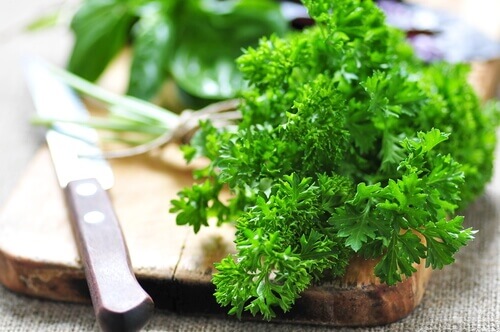
Possible benefits of parsley
It’s worth pointing out that all parts of this plant can be used (the roots, seeds, leaves, and stalk). Parsley is used as a:
Diuretic
May help increase urine production in the kidneys and is great for fighting kidney infections, treating or reducing the risk of kidney stones, and reducing fluid retention (edema). To address these issues, prepare a tea or juice:
Ingredients
- 1 handful of parsley leaves and stalks
- 250 mL of water
Instructions
- Bring the water to a boil.
- Add the parsley and allow it to cook for a few minutes.
- Allow to cool and then strain.
- This can be drunk either hot or cold, and it can be sweetened with honey.
Hypotensor
This is due to the fair amount of potassium in parsley, and for the aforementioned diuretic effect.
- Consume it in an infusion or smoothie once a day.
Read more here: Detox Your Liver with this Amazing Parsley and Mint Tea
Emmenagogue
Parsley can be the perfect remedy for women with painful periods. This plant may also promote menstrual flow.
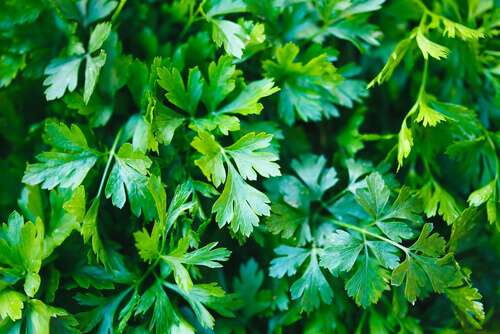
Digestive and laxative
This is because parsley may help increase gastric secretions, fight intestinal gas, and also fight jaundice.
Cleanser
Parsley is considered to be an excellent and potent antioxidant and may help cleanse the body. It may help disinfect the intestines and lungs, boost waste removal through the urine, and help detoxify both the liver and gallbladder.
Hormone regulator
Menopausal women are advised to consume more parsley in salads, sauces, creams, and smoothies because it may help balance hormone levels, especially estrogen.
Aphrodisiac
Since ancient times, people believed this plant boosted libido and sexual desire. The scientific explanation states that this is due to parsley’s phytoestrogens, which may:
- Tone the uterus.
- Promote menstruation.
- Improve milk production.
- Boost female libido.
- Facilitate labor during birth.
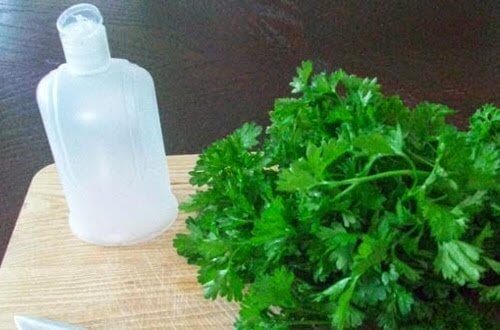
Parsley for beauty
Beyond the amazing possible benefits of parsley and its medicinal properties, we should also point out its great effects when used externally or internally that may help:
- Eliminate tiny red veins on the face (rosacea).
- Reduce excessive skin oil.
- Reduce dark marks on the skin.
- Bring shine to one’s complexion.
- Eliminate blackheads.
- Reduce acne outbreaks.
- Speed up wound healing.
Parsley can be used to make an excellent beauty mask:
Ingredients
- One handful of fresh parsley
- A bit of warm water
- 1 teaspoon of lemon juice
- 1 tablespoon of honey
Instructions
- Cut the parsley as small as possible and grind it into a paste with the warm water (just a small amount) in a mortar and pestle.
- In a separate bowl, mix the honey with the lemon juice and pour into the previous mixture.
- Wash your skin with warm water and neutral soap.
- Apply the mask to the area you wish to treat and leave on for 10 to 15 minutes.
- Rinse with warm water.
- To finish, apply a moisturizing cream.
Remember that this treatment must be done at night because if the lemon juice comes into contact with the sun, it may stain your skin.
Repeat this treatment once a week for best results. If the mask burns a little when you apply it, this is because you already have an acne outbreak. The burn will go away within a few minutes. If not, rinse it off.
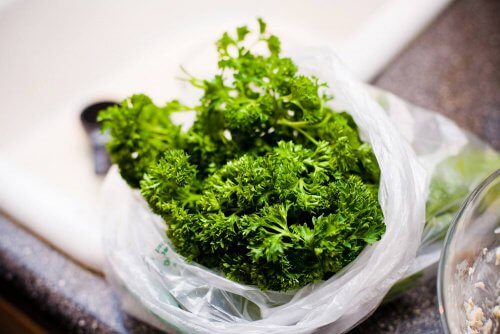
One other way to use parsley aesthetically is to prepare it as a tea to then be applied as a tonic:
Ingredients
- 1 handful of parsley leaves and stalk
- 1 cup of water (250 mL)
Directions
- Heat the water, add the parsley and allow to set until the water is lukewarm.
- Strain.
- Dip a cotton ball in the tea and then apply to the affected area after cleaning and drying it.
This tonic may help reduce the appearance of blemishes.
We hope you enjoyed reading about the possible benefits of parsley!
All cited sources were thoroughly reviewed by our team to ensure their quality, reliability, currency, and validity. The bibliography of this article was considered reliable and of academic or scientific accuracy.
- Working group of the GesEPOC. (2017). Nutrición. Archivos de Bronconeumologia. https://www.sciencedirect.com/science/article/pii/S0300289617303654?via%3Dihub
- Galarza, V., & Cabrera, G. (2008). Hábitos alimentarios saludables. Nutrición, Salud y Alimentos
- Rindfleisch, D. R. y J. A. (2008). Dieta antiinflamatoria. Medicina Integrativa. David Rakel MD.
- Kreydiyyeh, S. I., & Usta, J. (2002). Diuretic effect and mechanism of action of parsley. Journal of ethnopharmacology, 79(3), 353-357. https://www.ncbi.nlm.nih.gov/pubmed/11849841
- Charles, D. J. (2012). Parsley. In Handbook of Herbs and Spices(pp. 430-451). Woodhead Publishing. https://www.sciencedirect.com/science/article/pii/B9780857090393500244
- Reyes-Munguía, A., Zavala-Cuevas, D., & Alonso-Martínez, A. (2012). Perejil (Petroselinum crispum): compuestos químicos y aplicaciones. Tlatemoani: Revista Académica de Investigación, 11, 18. http://www.eumed.net/rev/tlatemoani/11/perejil-compuestos-quimicos-aplicaciones.pdf
- García, J. S. P. (n.d.). Consumo de fitoestrógenos dietarios en mujeres guatemaltecas de 25 a 60 años de área rural y de área urbana. http://biblio3.url.edu.gt/Tesario/2012/09/15/Penados-Jacqueline.pdf
This text is provided for informational purposes only and does not replace consultation with a professional. If in doubt, consult your specialist.








